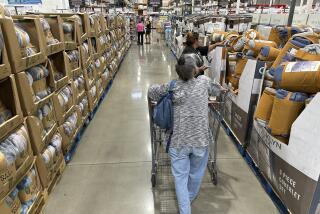Earlier Recessions of Little Help in Forecasting ‘Double-Dip’ in Economy
- Share via
Many U.S. economic statistics turned up this spring, apparently vindicating those forecasters who have predicted that the recession would be relatively short and mild. Indeed, real gross national product, the broadest measure of economic activity, rose slightly in the second quarter, according to preliminary estimates released recently.
The economic gurus of the National Bureau of Economic Research do not identify turning points until well after the fact. On the evidence now, the recession seems to have ended in the second quarter and we are now starting an economic recovery.
But this happy outcome is not assured. A group of more pessimistic forecasters expect that we are in for a double-dip recession. They see the modest bounce back as merely an aberration in an economy that is still caught in a deepening recession. On their reading of the situation, the economic news will soon turn bad again, with rising unemployment and falling output and profits in the quarters ahead.
The double-dip forecasters base their case on three propositions. First, the last two recessions have been double- dippers, with an early recovery or near recovery followed by a renewed deepening of the recession. Second, there were too many special problems coming into this recession, including the loan losses in thrifts and banks, overbuilding in many cities and the budget problems of state and local governments. Recovery cannot get under way until they are at least partially solved. Third, the economic statistics of the second quarter have in fact been a mixed bag rather than an unambiguous picture of economic recovery.
The last proposition is the most worrisome. The recent economic news has indeed been fair rather than great, and a month of improvement has sometimes been followed by a month of backsliding. For example, retail sales (other than autos) were up strongly in May, only to fall again in June. Orders for new business capital goods, which are a forerunner of business investment spending on new equipment, had risen gradually in April and May but then fell sharply in June. After trending downward since March, new claims for unemployment insurance ticked up in early July.
Other evidence points more consistently toward recovery. Home sales and permits for new home construction have risen every month from their very depressed levels last January. Industrial production has risen for three straight months. On balance, the monthly stream of information on the economy still points to recovery--but one that is not so strong that it could not be derailed.
The second proposition involving special problems rests more on fundamental views about the economy than on deciphering recent data flows. There is little doubt that the speculative excesses and inadequate supervision of the 1980s have left financial institutions in the worse shape than since the 1930s. And those institutions can add to problems in the rest of the economy by rationing credit and by being excessively cautious in making new loans as they attempt to improve their balance sheets.
The huge oversupply of commercial and office buildings that has developed in many markets will depress non-residential construction for years to come. But bad as these special problems are, they have been around for a time and probably will depress the economy less, rather than more, than they have in the recent past. The exception is the state and local budget situation, which will act as a greater drag on the economy this year and next as states and municipalities raise taxes and cut their spending. All in all, such special problems probably will make the recovery slower than usual, not to kill expansion altogether.
What of the first proposition, that the two previous recessions in 1973-74 and 1979-80 were double-dippers, implying that there is probably a force that tends to produce such a pattern? This overlooks what was very special about those two recessions. During both sharply higher oil prices added dramatically to already worrisome inflation rates. In response, monetary and fiscal policies were geared to slowing inflation even at the cost of a severe economic recession. And in both cases, special shocks caused an abrupt beginning to recession well before the gradual effects of policies would have caused one--gasoline lines collapsed car sales at the start of 1974 and a presidential call for restraint in using consumer credit created a precipitous drop in consumer spending in the first half of 1980. Once these shocks were absorbed, output recovered somewhat before the continued tight money policies brought on the second, and deeper, stage of recession.
These previous recessions are an unlikely model for our immediate future because the problems confronting the Federal Reserve are so different this time. Rather than being dedicated to reducing a dangerous inflation, the Fed appears clearly eager to avoid any further downturn in the economy. If the monthly statistics reveal renewed weakness in the economy, or if the fundamental problems in certain sectors begin to threaten the overall expansion, we should expect to see a push to lower interest rates rather than an indifferent Fed that permits the recession to enter a second and deepening stage.
More to Read
Inside the business of entertainment
The Wide Shot brings you news, analysis and insights on everything from streaming wars to production — and what it all means for the future.
You may occasionally receive promotional content from the Los Angeles Times.










